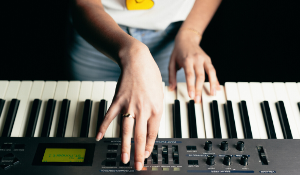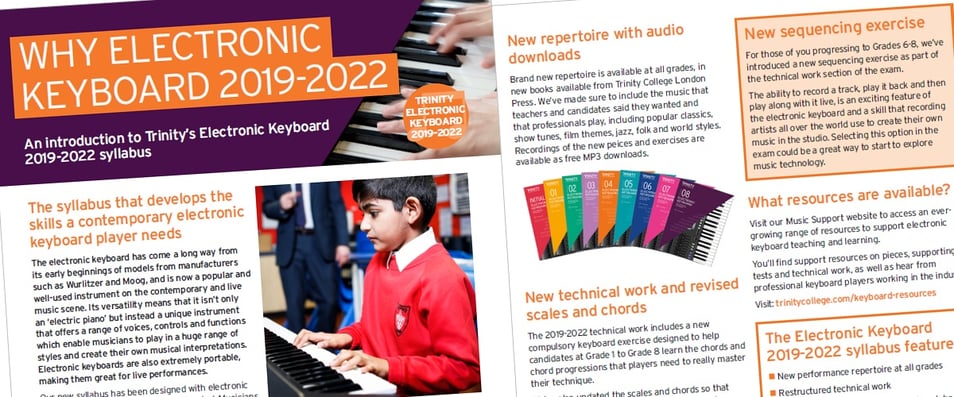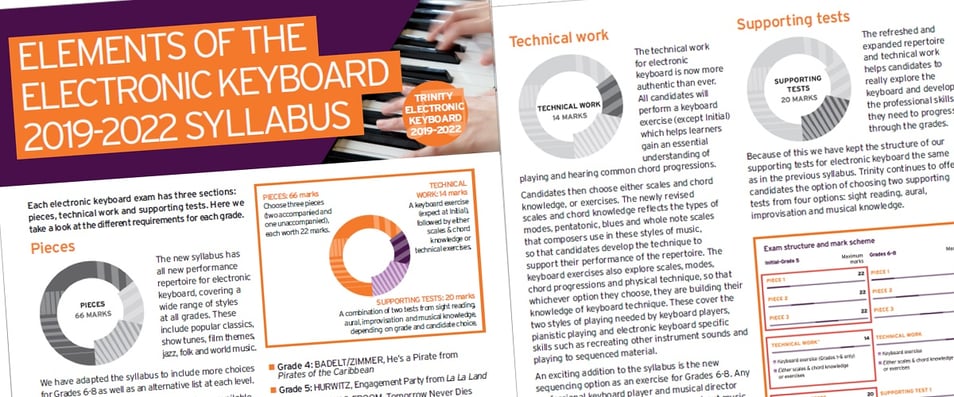Technical work: the new keyboard exercise - Grade 1

In the first part of this series prepared from a selection of advice from electronic keyboard specialists, we introduce the new keyboard exercise and explore how it works at Grade 1. In this article, we give teachers some ideas about how to approach the keyboard exercise and the way in which it can help develop a wider understanding of chord knowledge and common chord progressions, how these link to the pieces candidates select for their exam and how they may also help develop improvisation skills (one of our supporting tests).
All of the suggested activities are available as a downloadable student handout.
Why a new keyboard exercise?
The electronic keyboard is a versatile instrument – it is a harmony instrument, a melody instrument, and a rhythm instrument too. As the electronic keyboard is used to play a wide range of music, its repertoire features arrangements of well-known tunes. So, to bring the best out of the melodies and songs when self-accompanying on the electronic keyboard, it’s important to have an awareness of the underlying harmonies and common chord progressions of these contemporary arrangements.
At Trinity, we have built our syllabus to be truly authentic and we know that learning musical technique is more effective if it relates also to performance. Chord knowledge is useful, but understanding how chords relate to pieces in a more contextualised way means that you’ll be applying your technique as you perform. Developing knowledge of the most common chords, together with other relevant performance and technical skills such as bass clef reading, finger dexterity and a sense of pulse, is what the new keyboard exercise is designed to do.
What is the new keyboard exercise?
The keyboard exercise comprises a scale in the right hand, accompanied by chords in the left hand. It is played with piano voice and auto-accompaniment off, so fully-fingered chords must be used. Here it is at Grade 1:

As we move through from Grade 1 to Grade 5 more chords and more frequent chord changes are introduced in the left hand, and the scale in the right hand increases from one octave to two.
Initial grade – starting with triads
Although the keyboard exercise does not begin until Grade 1, it’s perfectly possible to start laying the groundwork from the Initial grade.
One way to introduce the concept of the primary chords is to build triads on each note of the scale. We can do this starting with C major, playing each triad in turn, as shown in the handout.
Some of these chords are major, some are minor, and are known as the primary chords. In particular, the C chord and the G chord are major, and we can think of these as our ‘home’ chord and our ‘away’ chord. We’ll return to the other chords in later grades.
Your students can really get a feel for these two chords by playing them firstly as block chords (try holding them for a four beat bar), and then as broken chords up and down the keyboard (you’ll need the auto-accompaniment turned off for this). They might want to make up little sequences e.g. C C G C – playing each as a block chord or as a broken chord with both hands (as shown in the handout) and see how that sounds. It’s good to note that this closely links in with the skills they would need to develop for the Improvising test (Harmonic Stimulus) at Initial – so a great way to develop musicianship all round!
Linking to the repertoire
An ideal place to start exploring how these chords link in with repertoire is Electronic Keyboard Exam Pieces & Technical Work 2019-2022: Initial – all 8 pieces are in C major, so your students are ready to go! To start, the teacher can play the melody and the student ignores the printed chords, but chooses to play either the C chord or the G chord underneath, fully fingered – notice how some notes sound better against the C chord and others against the G?
Then swap, so the teacher plays the triads (only C or G) whilst the student plays the melody on top. Notice how some notes sound better against the C chord and others against the G chord? And there are some notes that can work comfortably against either chord. But there will be some notes in the melody that ‘don’t sound right’ against the chord being played, so encourage your student to move to the note next door – does that sound better? This is a fun exercise that – especially with the rhythm backing off – gives the pupil time to think and try different pitches, and in doing so start to develop a sense of how harmony works.
Improvising skills
Of course, this links in with developing improvisation around chords I and V – which is one of the optional supporting tests at Initial grade (harmonic stimulus). A perfect scale to use for that is the pentatonic – one of the scales covered at Initial for electronic keyboard. Here is an example of what could be played, initially by teacher and pupil and eventually by the pupil on their own:
.png?width=2303&name=Fig%202%20(4%20bar%20sequence%20in%204-4).png)
To encourage your student’s creativity, you may like to:
- change from 4-time to 3-time
- encourage your students to make use of rhythms they have learned in their pieces
- move hand position to the inverted pentatonic (the same notes, but starting on the G). Here is an example that illustrates all three:
.png?width=2303&name=Fig%203%20(4%20bar%20sequence%20in%203-4).png)
The rhythm here has been taken from the 'Skye Boat Song' (Initial), which is built around the notes of the pentatonic.
The V-I progression
As you finish looking through the pieces at Initial, you may want to introduce basic Roman numeral notation to your student, as a preparation of moving towards other keys: the ‘home’ chord is chord I, and the ‘away’ chord is chord V. Notice how many pieces end with chords V followed by chord I (i.e. G followed by C). 'Buttercup' and 'Brahms Lullaby' are two examples – can your student find any more?
Grade 1 – introducing new keys
In Grade 1 we take all of this knowledge and apply it to the new keys of G major and D minor, which feature in the technical work for the grade.
This is explored in the handout, which repeats the approach of block chords and broken chords in these keys, and also introduces the Roman numeral notation of small letters for minor chords (as used in the Trinity Theory of Music Workbooks).
Chord progressions
Why not encourage your students to set up some 4 bar ‘sequences’ (or chord progressions) of their own, finishing with the home chord each time. Here is an example in G major:
%20NEW.png?width=2303&name=Fig%204%20part%201%20(4%20bar%20sequence%20in%20G%20major%20LH)%20NEW.png)
%20NEW.png?width=2303&name=Fig%204%20part%202%20(4%20bar%20sequence%20in%20G%20major%20RH)%20NEW.png)
%20NEW.png?width=2303&name=Fig%204%20part%203%20(4%20bar%20sequence%20in%20G%20major%2c%20broken%20chords)%20NEW.png)
Download as MIDI file (broken chords)
Again, they can use the corresponding pentatonic scale to improvise (as illustrated in the handout).
Many well-known nursery rhymes and children’s songs use this very sequence (I I V I): 'London Bridge is Falling Down', 'Mary Had a Little Lamb', 'Alouette' to name a few. Whereas the refrain from 'Ode to Joy' uses the same chords in a slightly different sequence – can your students work it out? Chords I and V can be found in all manner of music – from early music right up to the current day.
Once your student is comfortable with chords I and V in the new keys, you can explore how the chords link in with the repertoire in Electronic Keyboard Exam Pieces & Technical Work 2019-2022: Grade 1 – with your student playing fully-fingered chords whilst you play the melody, and vice-versa.
'Pastoral' uses chords I and V exclusively, and 'Whirling Dervishes' is another one that’s good to look at, as it’s in the key of D minor, which we meet at Grade 1:

Chord inversions
Back at Initial, we introduced a way of playing the G chord comfortably against the C chord (see page 2 of the handout). Notice how much easier this is to play than having to move hand position up to the G.
Can your student work out what we have done here? The bottom note of the triad has been moved to the top, which is known as an inversion. The handout shows chord inversions for the three keys encountered so far: C major, G major and D minor.
Chord inversions are suggested in the keyboard exercise, but are not required. Here is the Grade 1 keyboard exercise in D minor:

As you can see we’re using exactly the same chords that we have been looking at here, and use the chord inversion in the left hand as described. Learning this scale in the right hand, and then adding the chords underneath in the left hand, is also a useful stepping stone to playing scales hands together at Grade 2!
In the next part of this series we’ll continue from Grade 2, where we introduce the remaining primary chord – chord IV – we meet the famous IV-V-I progression, and learn about 7th chords. Coming soon.



